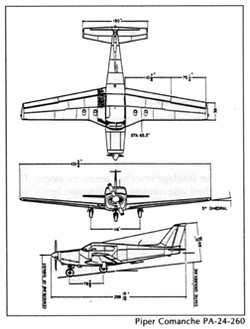Controller Instructed Pilot To "Keep Your Speed Up" and
"Maintain Maximum Forward Speed"
 An aircraft operating in VFR conditions but under an IFR flight
plan was found to have broken up, prior to impact, according to
information recently imparted by the NTSB. The pilot stopped
communications with controllers less than a minute after being
instructed to keep his speed up during his descent.
An aircraft operating in VFR conditions but under an IFR flight
plan was found to have broken up, prior to impact, according to
information recently imparted by the NTSB. The pilot stopped
communications with controllers less than a minute after being
instructed to keep his speed up during his descent.
The NTSB Preliminary Report states:
NTSB Identification: WPR09FA192
14 CFR Part 91: General Aviation
Accident occurred Saturday, April 11, 2009 in San Diego, CA
Aircraft: PIPER PA-24-250, registration: N7690P
Injuries: 2 Fatal.
This is preliminary information, subject to change, and may
contain errors. Any errors in this report will be corrected when
the final report has been completed.
On April 11, 2009, about 1054 Pacific daylight time, a Piper
PA-24-250, N7690P, owned and operated by the pilot, experienced an
in-flight breakup during an uncontrolled descent, in San Diego,
California. Airplane wreckage was located on a hillside about 5.5
miles east-northeast of the Miramar Marine Corps Air Station. The
airplane was destroyed during the breakup sequence and post impact
ground fire, and the private pilot and passenger were killed.
Visual meteorological conditions prevailed at the time, and an
instrument flight plan was filed for the personal flight. The
flight was performed under the provisions of 14 Code of Federal
Regulations Part 91. The flight originated from the Whiteman
Airport, Los Angeles, California, about 1004.
According to the Federal Aviation Administration (FAA), the
pilot did not report experiencing any difficulties or abnormal
conditions during the flight. The pilot's instrument flight plan
and clearance was to the Brown Field Municipal Airport (SDM) in San
Diego.
Multiple cloud layers existed in the accident site area. At
1055, Miramar (elevation 478 feet mean sea level (msl)) reported a
broken sky condition at 2,500 and 3,100 feet above ground level,
and an overcast sky condition at 4,800 feet above ground level. The
visibility was 10 miles, and the temperature was 13 degrees
Celsius.
About 1051, when the pilot was approximately 29 miles north of
SDM, he informed a FAA Southern California Terminal Radar Approach
Controller (SOCAL) that he was descending from 6,200 to 4,000 feet
msl. The controller acknowledged the pilot's statement. For
unspecified reasons, about 2.5 minutes later, the controller
instructed the pilot to descend to 2,600 feet. The controller also
instructed the pilot to "keep your speed up" and "maintain maximum
forward speed."
 According to the FAA, at 1053:07, the airplane's Mode C
altitude reporting transponder indicated that the airplane was at
4,200 feet. At 1053:11, the airplane was at 3,800 feet, and at
1053:16, the airplane was at 3,300 feet.
According to the FAA, at 1053:07, the airplane's Mode C
altitude reporting transponder indicated that the airplane was at
4,200 feet. At 1053:11, the airplane was at 3,800 feet, and at
1053:16, the airplane was at 3,300 feet.
During this interval of time, FAA radar indicated that the
southbound airplane's course was changing. The airplane was turning
in a clockwise direction. By 1053:16, the airplane was on a
westerly course. Within about 3/4-minute of the controller's
issuance of the descent and maximum speed instruction, radio and
radar contact had been lost with the airplane.
A ground-based witness, who was located within 3/4-mile of the
accident site, reported that he observed a hillside fire and looked
upward. He described seeing objects falling down above the accident
site area. The objects he saw were subsequently found and were
determined to be pieces from the accident airplane.
Miramar's Marine Corps personnel provided assistance to the
National Transportation Safety Board's investigation team in
locating airplane components on its base property. The components
were found at elevations between 870 and 1,010 feet msl. The
airplane's outboard wing spans were located about 400 feet away
from the main wreckage impact crater.
The inboard wing spans, vertical stabilizer with attached
rudder, and the left stabilator were found attached to the main
wreckage and were fire-damaged. The entire fuselage and cockpit
were consumed by fire.
Components located hundreds of feet away from the main wreckage
were not burned. The Safety Board's wreckage examination revealed
that the airplane's wing spars were bent and fractured in an upward
direction. The right stabilator was found separated from the
empennage, and its airframe attachment structure was observed bent
in an aft direction. The leading edge of the stabilator was also
crushed in an aft direction, and it bore witness marks that were
consistent with separated right wing component structure.
 ANN's Daily Aero-Linx (04.16.24)
ANN's Daily Aero-Linx (04.16.24) Aero-News: Quote of the Day (04.16.24)
Aero-News: Quote of the Day (04.16.24) Airborne 04.10.24: SnF24!, A50 Heritage Reveal, HeliCycle!, Montaer MC-01
Airborne 04.10.24: SnF24!, A50 Heritage Reveal, HeliCycle!, Montaer MC-01 Airborne 04.12.24: SnF24!, G100UL Is Here, Holy Micro, Plane Tags
Airborne 04.12.24: SnF24!, G100UL Is Here, Holy Micro, Plane Tags Airborne-Flight Training 04.17.24: Feds Need Controllers, Spirit Delay, Redbird
Airborne-Flight Training 04.17.24: Feds Need Controllers, Spirit Delay, Redbird




